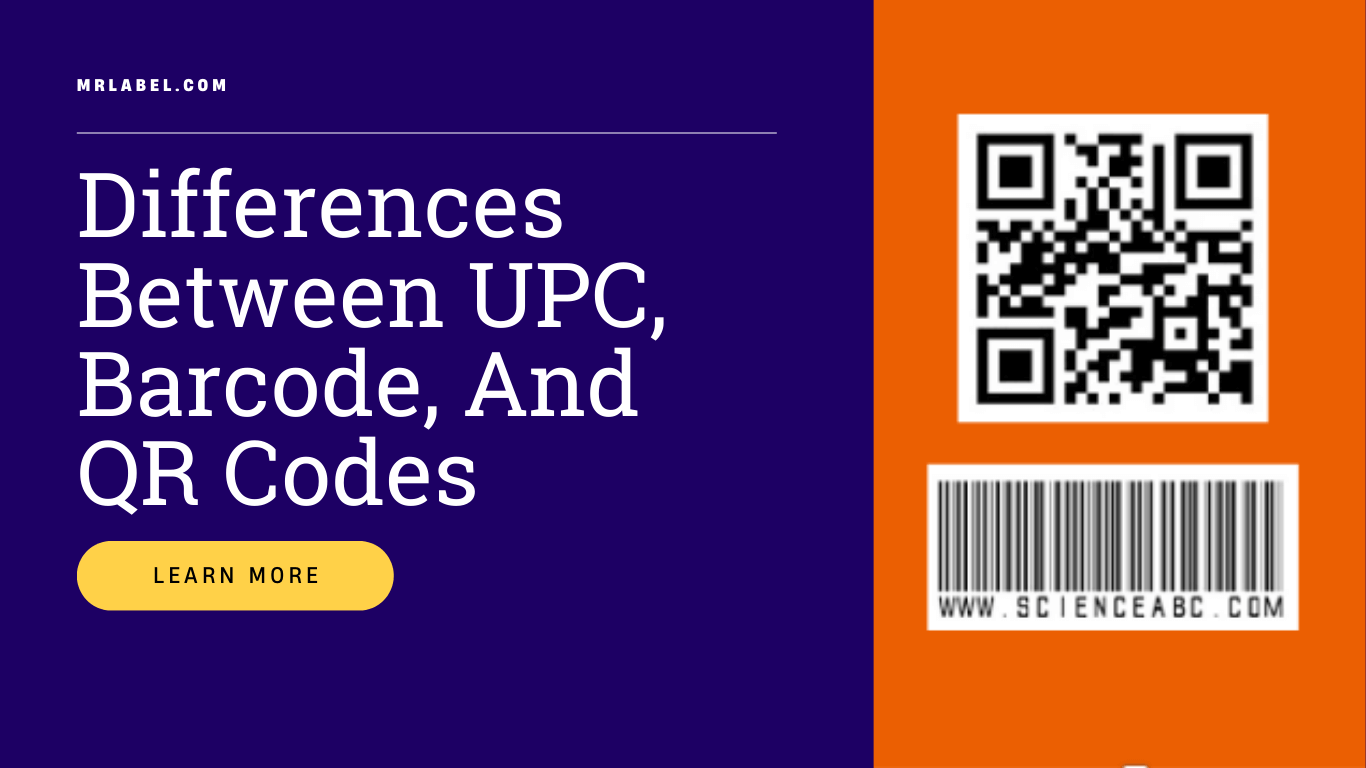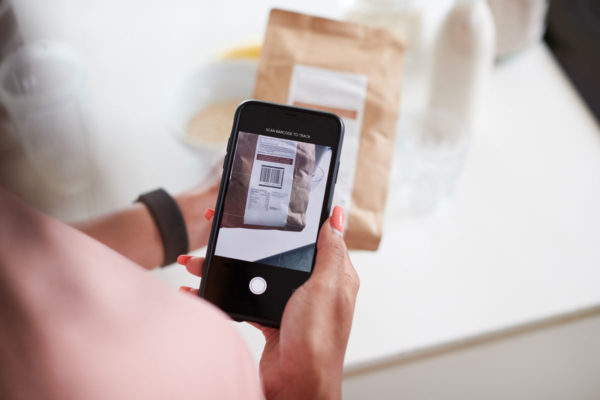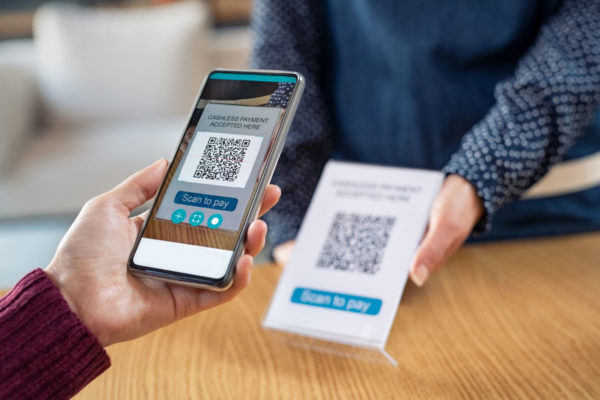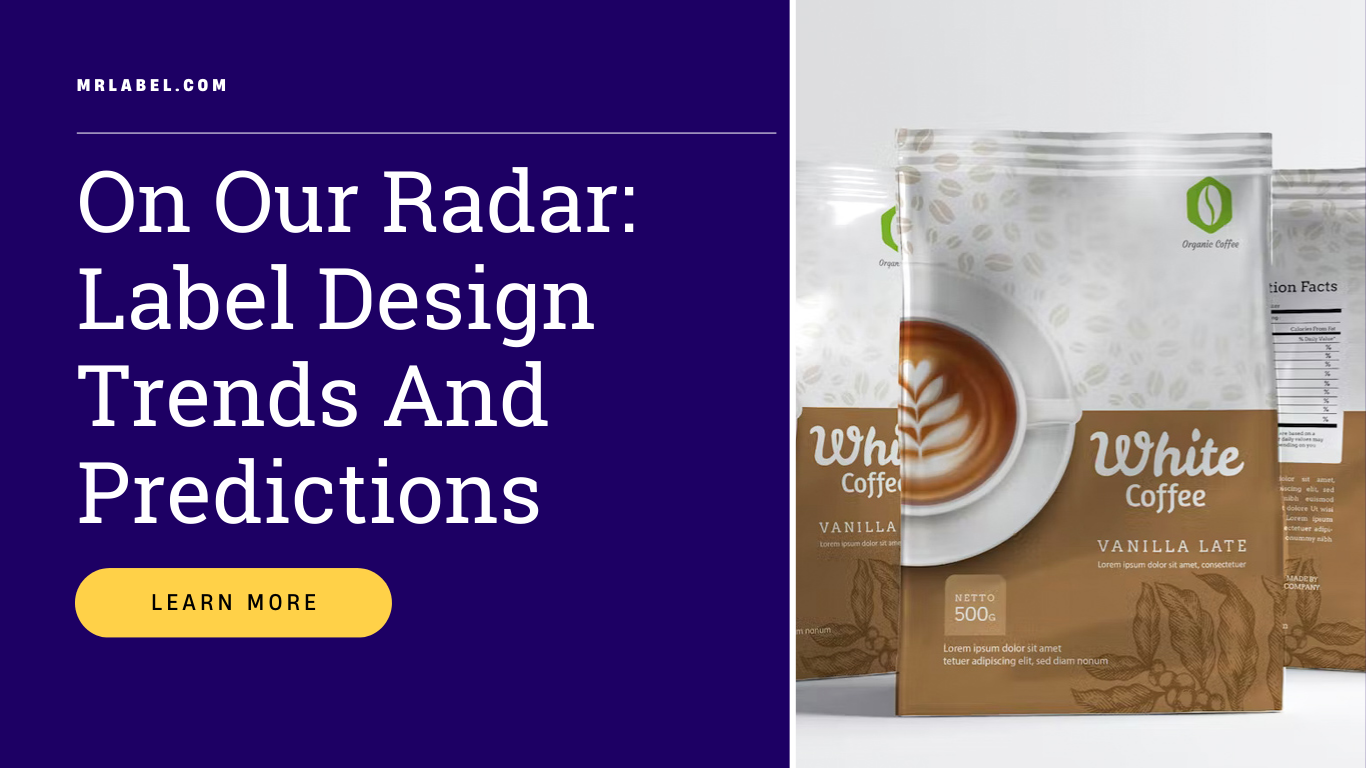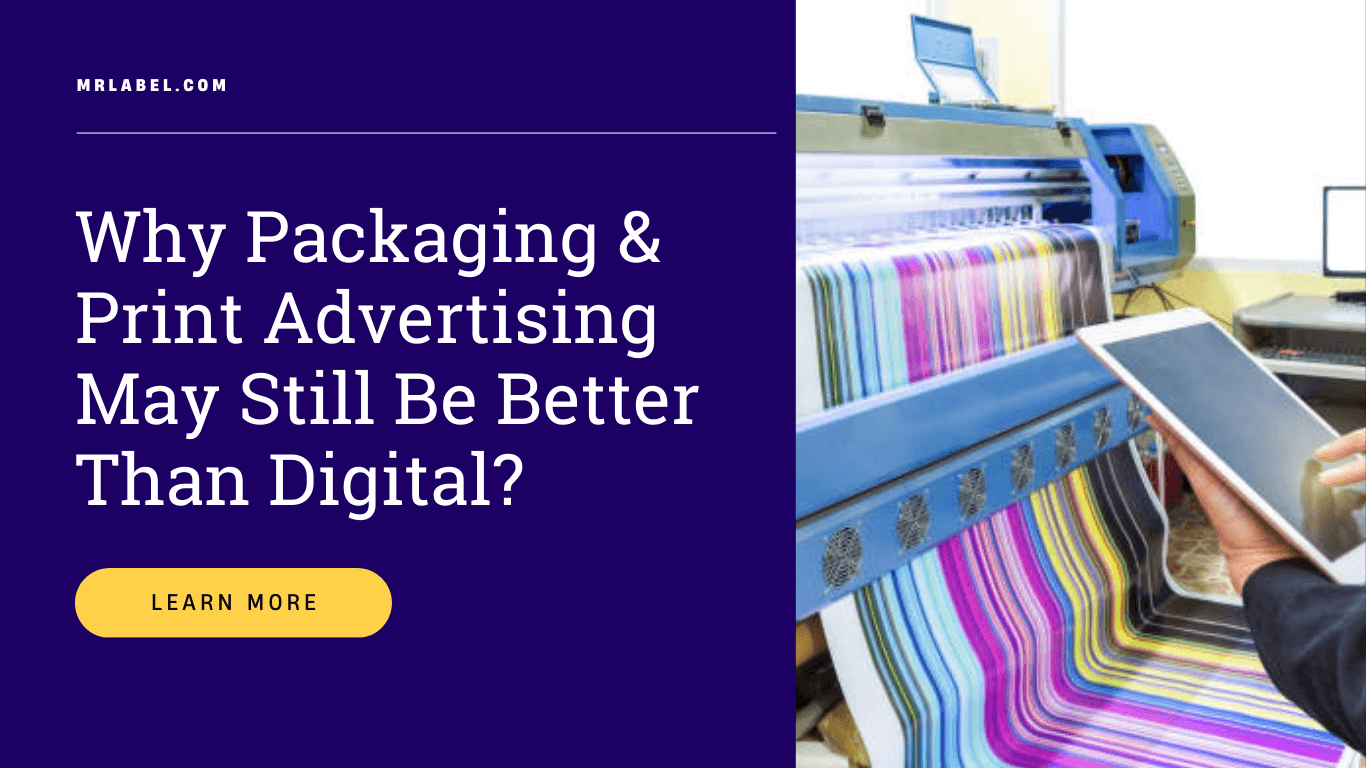When designing custom product labels and packages, don’t forget about barcodes! An effective label not only needs to attract the eye of distracted consumers, but they also need to provide important information for retailers. Did you know that there are actually a variety of different ways to track your products and provide information? Various codes such as UPC, barcodes, and QR Codes all provide value for different types of products and purposes!
When manufacturing products for sale, managing and tracking inventory is a high priority. That’s why unique codes have been created to identify, quantify, and keep track of inventory both in your warehouse and once it’s been distributed to retailers. Unsure what each of these codes are for or which type are best for your product labels? M&R Label is happy to guide you! In this blog, we share the differences between a UPC, barcode, and QR Codes – as well as common uses for each type…
UPC
UPC means Universal Product Code, which is a unique identifier for every individual product. The word “universal” comes from the ability to allow your product to be scanned in countries around the world, instead of in one region. This unique 12-digit number assigned to retail merchandise identifies both the product and the vendor that sells the product. UPC is usually printed on a product next to its barcode, which is the machine-readable representation of the UPC. Thus barcodes and UPC go hand in hand.
“Each individual product that you are planning on selling will need its own unique UPC Code. Each variant of product will require a unique UPC so products of different size and colors will each be unique represented with an individual UPC. The GS1 Barcode Service helps companies with every step of obtaining their own UPC.” Barcode-US
How can my business obtain a UPC?
The first step toward getting a 12-digit UPC barcode is to join GS1. GS1 is an international group that created UPCs to help standardize the way that vendors track products both online and in stores. The group has different divisions across the country, and GS1 U.S. covers the United States. The GS1 Company Prefix is a unique number that will identify your company as the owner of your barcode and the product it’s on. Once you obtain your UPC and barcodes, you’ll then send them to M&R Label to incorporate them on your labels!
Barcodes
A barcode is a one-dimensional code that can be read by machines. They’re made of a pattern of black vertical lines of varying widths. Barcodes are usually accompanied by numbers as well. Thus, if a barcode isn’t easily readable, the code can be manually entered instead. These codes can contain important information such as manufacturer name, article type, price, etc. The data that barcodes can hold is limited and they’re mainly used to identify an item type, rather than individual items.
“Barcodes are ubiquitous. They’re the most common auto-identification technology used for stock control and to store basic information about products. Historically, a barcode scanner has usually been required to read the information in the barcode, but nowadays, even your smartphone can interpret this data.” Itemit
How can my business obtain barcodes?
Once your business has obtained a UPC, you’ll need to get a barcode that matches your 12-digit codes. Every barcode must match your UPC. The good news is that GS1 includes machine readable barcodes along with the UPCs that your business licenses. Members can use the GS1 U.S. Data Hub to create high-resolution artwork to include on product labels. Learn more on the GS 1 U.S. website! The GS1 Company Prefix is a part of every barcode you will create. Prefixes are available in different “capacities” that allow you to barcode as few as 10 unique products and as many as 100,000 unique products. You’ll need a barcode for each product variation, such as size and color. Choose a prefix capacity that best meets the needs of your business now and in the near future. Use their barcode estimator tool!
QR Codes
Quick Response Codes, also known as QR Codes, are similar to barcodes, except they are two-dimensional. This means they are made of information in both vertical and horizontal directions. You’ll commonly see a mixture of black and white squares and dots. QR Codes can contain many different types of data, such as social media links, website URLs, email addresses, or contact info.
“QR Codes have grown in popularity over the last decade due to the rise of smartphones. There are certain QR Code scanner apps that can be downloaded for free on smartphones. So once you see a QR Code, just scan it with your phone’s app, the app usually uses the phone’s main camera to scan the code, and the pre-set action such as opening a web page, sending a tweet, downloading an app etc. that is attached to the code is triggered.” Science ABC
How can my business obtain a QR Code?
The process of creating a unique QR Code for your business is not as official as obtaining UPCs and barcodes. Anyone on the internet can create a QR Code! There are many free QR Code generators on the internet that you can use, simply follow their instructions and fill in the information you want included. You’ll then download an image file and send the file to M&R Label for printing!
The Benefits of Utilizing UPC, Barcodes, and QR Codes for Your Products
As UPC and barcodes typically go hand in hand, we recommend every product’s label showcases these identifiers. As for QR Codes, these are very convenient codes that can be used in many ways! You may be thinking “I’m a small business owner, I don’t need barcodes or QR Codes”. However, if your business sells products and tracks inventory, or wants to engage with customers in an interactive way, then all of these solutions are useful!
Check out the many benefits of including these types of data and identifiers on your custom product labels:
- Need to track inventory? Utilizing both Universal Product Codes and barcodes will make your inventory management system much at your warehouse, wholesalers, and retailers much easier!
- Tired of having to manually look up each product for pricing and other info? Both UPC labels and QR Codes facilitate quicker checkout experiences, resulting in happier customers and a simpler job for employees at the register!
- Worried you can’t include everything you want on your labels? QR Codes can store much more data than barcodes, so if you want to share additional information without crowding your product label with too much content, these are the way to go!
- Looking to cut costs? Designing and printing barcodes is very cost effective, you can print thousands at a very low price!
- Planning a special promotion, marketing campaign, or to increase social media following? QR Codes are perfect for helping customers download apps, retrieving coupons/discount codes, and providing links to your website or social media accounts!
- Not sure how to use barcodes for more than just products? They are super versatile and can be used on any surface or shape, making them great for tracking products, equipment, and outgoing shipments!
- Not sure how to use QR Codes? You can use QR Codes on any medium such as business cards, brochures, product packaging, displays, receipts, and much more!
Tips to Keep in Mind When Designing Custom Labels with UPC, Barcode, and QR Codes
UPC and Barcodes
Check out these top tips from Q Basis Tech for incorporating barcodes on your product label design:
- “Follow Barcode Size and Dimension Requirements: Larger barcodes usually scan more easily. However, the size of your barcode should match the size of the packaging and should depend on the intended scanning environment. In addition, there are standard minimum and maximum size requirements dictated by the type of barcode you are aiming for.
- Use Proper Color Combination: The most well-recognized color formatting of barcodes is solid black bars on a white background. This format scans reliably than any other color combination. Scanners recognize and read the bars by using infrared light, distinguishing the contrast between the colors. Always remember that the winning combination is dark bars on a light background.
- Leave Enough Space for Quiet Zones: Quiet zones notify the scanner where the start and end of a barcode is. In one-dimensional barcodes, quiet zones are the clear areas before the initial bar and after the last bar. Quiet zones in two-dimensional barcodes are the light area of the label itself.
- Plan Barcode Placement Strategically: Another important part of designing a barcode label is to strategize its position on the product or its packaging. It should be placed on a clear, unobscured part of the product for convenient and promising readability. It is also helpful to position it on a specific part of packaging consistently so the people scanning the item would not encounter difficulty finding it.”
QR Codes
QR Code Generator shares several key tips to keep in mind when designing QR codes for label printing:
- “Use a Frame with a Call-to-Action (CTA): By adding a frame for your QR Code to “stay on,” it can add more prominence and draw attention to the QR Code. Select from a variety of frames with a Scan Me text that urges people to take the next step when they encounter your QR Code.
- Change the Shape of your QR Code: Changing the shape means that you’re changing the pattern of the small, pixelated squares that represents the QR Code’s data. You can differentiate your QR Code from your competitors just by making small changes to its appearance.
- Pick and Choose Your Own Color. Using our color picker, you can select from 16,777,216 HEX colors using the #RRGGBB notation. It is impossible to design a QR Code with a color you dislike, so feel free to experiment. Just one piece of advice: Stick with darker shades to ensure that your QR Code remains scannable.
- Add Your Logo. For some finishing touches, you can choose a SCAN ME logo for the center of your QR Code or upload your own when you sign up. By using your logo, you can foster brand awareness and establish trust among your audience.”
Trust the Printing Experts at M&R Label to Design and Print Premium Product Labels
While UPC, barcodes, and QR Codes aren’t the “sexiest” part of your label, they are extremely important and valuable! Let’s make sure your labels are designed in the best way possible so they are equally aesthetically pleasing, provide all the necessary information, AND make a great impression on your customers!
We are very happy to assist you in creating UPC, Barcodes, and QR Codes! Otherwise, you can create these codes online and then send us the files to use to make sure we incorporate them on your custom labels. The next step is making sure the codes are set up properly for a successful printing experience! At M&R Label, we have printed countless barcodes for products and tracking shipping across all industries. You can rest assured that your labels are in good hands! Our team will use proper colors, sizing, and spacing to ensure that these codes are easy to notice, read, and scan.
Other important considerations for your label design include choosing appropriate materials for your product label and making sure the label printer offers the best printing techniques for your needs – we know we do! We suggest that your business utilizes our Digital Label Printing and Variable Data Label Printing services. Digital printing is an economical way for printing prime, custom, short run label orders. Variable data printing is done digitally and allows us to change information, such as text or images, from one label to the next without stopping or slowing down the printing process. Variable label printing also gives customers a fast, affordable solution for printing custom labels that require slight variances, such as add barcodes, consecutive numbering and other identifiable markings.
When you choose to work with M&R Label, you can be confident that we are experts in designing and printing custom labels. Our 30+ years of experience and talented team are the perfect combination for a successful label printing experience. We have established ourselves as a trusted printing partner and have helped to define what “high quality” custom labels mean for every industry.
Exceeding customer expectations time and time again is our number one priority! Our motto is: the customer has, and always will, come first. We think of our customers as family and we will do everything we can to help you achieve your goals and be successful!
The M&R Label team is committed to providing impressive labels at a fair cost, along with extensive label printing & design knowledge. We will do whatever you ask of us, not the other way around! We’re happy to print any unique font, vibrant color, or image you need – on any type of material and shape!
In this highly competitive marketplace, it’s critical to make sure you’re using premium labels that stand out from the rest! Whatever products you are selling, these items need labels & packaging that will grab the consumer’s attention.
Interested in working with us? Ask to see our portfolio for samples! As your chosen custom label printer in Chicago, we guarantee quick turnaround, high quality materials, and creative label design.

